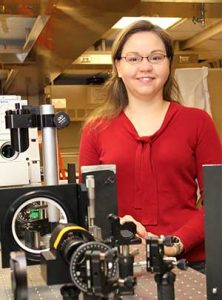The saying “Don’t put all your eggs in one basket” is being put to the test with research funded by the U.S. Department of Energy (DOE) to deconstruct plant cell walls as a means of learning how to more effectively convert plant material into bioenergy. The project has been awarded $1 million per year for three years.
 The research will be conducted at Ames Laboratory and led by Emily Smith, Ames Lab scientist. The goal of the study is to develop a subdiffraction Raman imaging platform. This platform, said Smith, will provide an unprecedented look at the specific chemical structures of plant cell walls. From there, the researchers will determine how best to deconstruct plant material as as source of biofuels. (In other news, DOE lab Oak Ridge National Laboratory is researching how to deconstruct plant walls using a supercomputer.)
The research will be conducted at Ames Laboratory and led by Emily Smith, Ames Lab scientist. The goal of the study is to develop a subdiffraction Raman imaging platform. This platform, said Smith, will provide an unprecedented look at the specific chemical structures of plant cell walls. From there, the researchers will determine how best to deconstruct plant material as as source of biofuels. (In other news, DOE lab Oak Ridge National Laboratory is researching how to deconstruct plant walls using a supercomputer.)
“The problem we have is that we can only get spatial resolution of a couple hundred nanometers due to the diffraction of light,” Smith explained, who is also an Iowa State University associate professor of chemistry. “When we look at plant cell walls at that resolution, we lose information about specific chemical details. At best, we get an average of the composition. However, if we can get to the subdiffraction level as we propose to do, it will open up new avenues to understanding the details of the cell walls. The trick,” continued Smith, “is to apply laser pulses in the right way so that you gain the resolution you need without destroying the sample in the process.”
According to Smith, the instrument will be unlike anything currently available used to study biomass. To build such a complex instrument, she is working with pulsed laser spectroscopy expert Jacob Petrich, as well as computational and theoretical expert Xueyu Song, both Ames Laboratory scientists and ISU chemistry professors. The instrument has its origins in the class of super-resolution imaging methods referred to as stimulated emission depletion (STED).
“We’ll be collaborating with (Ames Laboratory scientist) Tanya Prozorov who has been doing in situ correlative optical and electron microscopy on biological samples in their natural, fully hydrated state,” Smith said. “By comparing our chemical analysis results with the high-resolution images Tanya can provide, we hope to better interpret what we’re seeing in these natural polymer structures.”
The team also will obtain input on plant cell walls and biomass from Olga Zabotina, Ames Laboratory scientist and ISU associate professor of Biochemistry, Biophysics and Molecular Biology, looking primarily at Arabidopsis and Brachypodium transgenic plants with modified cell walls, which were generated in the Zabotina lab as a toolset to understand cell wall impacts on plant fitness and biomass quality.
The group will also eventually investigate what happens as microbial action breaks down the plant cell walls. Ames Laboratory scientist and ISU assistant professor of Chemical and Biological engineering Zengyi Shao will provide a variety of microbes and enzymes, to identify and possibly tailor the ones that provide the best pathways to break down the cell wall structures into the most advantageous materials for biomass conversion.

